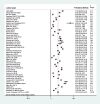Prevalence and determinants of adolescent pregnancy in Africa: a systematic review and Meta-analysis
- PMID: 30497509
- PMCID: PMC6267053
- DOI: 10.1186/s12978-018-0640-2
Prevalence and determinants of adolescent pregnancy in Africa: a systematic review and Meta-analysis
Abstract
Background: Adolescence is the period between 10 and 19 years with peculiar physical, social, psychological and reproductive health characteristics. Rates of adolescent pregnancy are increasing in developing countries, with higher occurrences of adverse maternal and perinatal outcomes. The few studies conducted on adolescent pregnancy in Africa present inconsistent and inconclusive findings on the distribution of the problems. Also, there was no meta-analysis study conducted in this area in Africa. Therefore, this systematic review and meta-analysis were conducted to estimate the prevalence and sociodemographic determinant factors of adolescent pregnancy using the available published and unpublished studies carried out in African countries. Also, subgroup analysis was conducted by different demographic, geopolitical and administrative regions.
Methods: This study used a systematic review and meta-analysis of published and unpublished studies in Africa. Preferred Reporting Items for Systematic Reviews and Meta-Analyses (PRISMA) guideline was strictly followed. All studies in MEDLINE, PubMed, Cochrane Library, EMBASE, Google Scholar, CINAHL, and African Journals Online databases were searched using relevant search terms. Data were extracted using the Joanna Briggs Institute tool for prevalence studies. STATA 14 software was used to perform the meta-analysis. The heterogeneity and publication bias was assessed using the I2 statistics and Egger's test, respectively. Forest plots were used to present the pooled prevalence and odds ratio (OR) with 95% confidence interval (CI) of meta-analysis using the random effect model.
Result: This review included 52 studies, 254,350 study participants. A total of 24 countries from East, West, Central, North and Southern African sub-regions were included. The overall pooled prevalence of adolescent pregnancy in Africa was 18.8% (95%CI: 16.7, 20.9) and 19.3% (95%CI, 16.9, 21.6) in the Sub-Saharan African region. The prevalence was highest in East Africa (21.5%) and lowest in Northern Africa (9.2%). Factors associated with adolescent pregnancy include rural residence (OR: 2.04), ever married (OR: 20.67), not attending school (OR: 2.49), no maternal education (OR: 1.88), no father's education (OR: 1.65), and lack of parent to adolescent communication on sexual and reproductive health (SRH) issues (OR: 2.88).
Conclusions: Overall, nearly one-fifth of adolescents become pregnant in Africa. Several sociodemographic factors like residence, marital status, educational status of adolescents, their mother's and father's, and parent to adolescent SRH communication were associated with adolescent pregnancy. Interventions that target these factors are important in reducing adolescent pregnancy.
Keywords: Adolescent pregnancy; Africa; Meta-analysis; Sociodemographic factors; Sub-Saharan Africa; Systematic review.
Conflict of interest statement
Ethics approval and consent to participate
Not applicable.
Consent for publication
Not applicable.
Publisher’s Note
Springer Nature remains neutral with regard to jurisdictional claims in published maps and institutional affiliations.
Figures






References
-
- WHO. Adolescents: Health Risks and Solutions. Geneva: World Health Organization; 2017. Available from: http://www.who.int/mediacentre/factsheets/fs345/en/
-
- WHO. Adolescent Pregnancy. Geneva: World Health Organization; 2014. Available from: http://www.who.int/mediacentre/factsheets/fs364/en/
Publication types
MeSH terms
LinkOut - more resources
Full Text Sources
Medical

